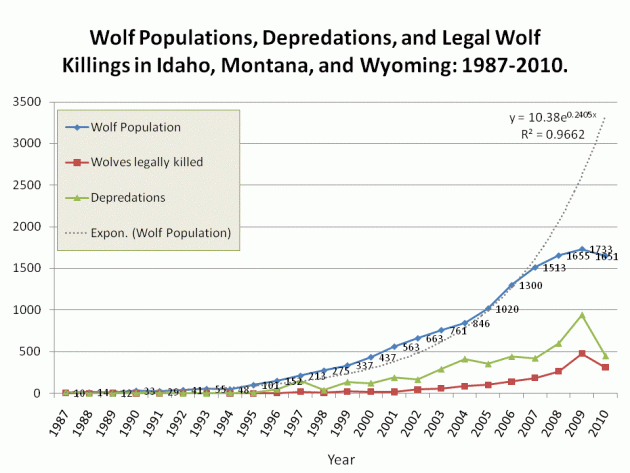Wildlife Conservation Science & Policy
Dedicated to the social and political aspects–the so-called "human dimensions"–of wildlife management
Wolf population growth stagnates…will the rhetoric?
Posted by on April 22, 2011
The image (above) shows (a) wolf populations, (b) confirmed domestic animal depredations (including livestock), and (c) the number of wolves legally killed (i.e., either via legal hunting or control) in Idaho, Montana, and Wyoming from 1987 to 2010. These data were aggregated from the USFWS’s 2010 report, which you can find here.
Despite predictions of continued growth, these data show a leveling off in wolf populations in these three states in the most recent 4 years. A closer examination reveals that while initially population growth was substantial, it has steadily decreased in recent years. In the first 5 years post reintroduction (1996-2000), the average annual wolf population growth was 34%, in the next five years (2001-2005) it was 27%; in the most recent five years (2006-2010), it was just 11%; and in the last three years it was 3%. This isn’t surprising given the fact that reintroduced wolves found unoccupied habitat full of elk that were unaccustomed to the predator. However, as the habitat has filled in, population growth has slowed, despite the dire predictions of some. Could wolves be reaching their carrying capacity in the Northern Rocky Mountains? Who knows. The more interesting question is: will the rhetoric of western politicians be toned down now with wolves delisted and populations stabilizing?

“The more interesting question is: will the rhetoric of western politicians be toned down now with wolves delisted and populations stabilizing?”
Short answer, No.
JB,
Without being emotional, do the politicians, ranchers, and hunters have access to this?
Immer
Nice propaganda…….
Sadly this information is incomplete, it fails to count uncollated packs, dispersers etc.
I can personally identify at least 5 packs in Idaho that are not a part of this ‘official’ count. Sadly, like so much concerning wolves, those who are bilking a living off of exploiting these animals will attempt anything that skews the information. Even DoW’s Idaho shill was admitting to over a thousand wolves in Idaho just a few short months ago. NOw that their income off of wolves is coming to an end….here comes more lies from partial information.
Of course that was before the fraud became so apparent that even congress couldn’t overlook it anymore.
Sop I guess the answer to the question is no, it doesn’t look like the pro wolf exploiters of wildlife are going to stop their rhetoric.
Barry,
These are estimates of the MINIMUM FALL POPULATION of wolves in the three states. The estimates include every wolf that the FWS can confirm. Of course there are some they cannot confirm, but that has always been the case (i.e., today’s estimates are subject to the same biases that they were last year and the year before, etc.). The point is, the data are most useful for examining population trends over time (thus the graph). In this case, they show that wolf populations have “leveled off” in ID, MT, and WY. This is no great surprise as wolves are limited by their prey base and the amount of suitable habitat. Whereas early on populations increased by expanding into new areas, their distribution within ID, MT, and WY has pretty much stayed the same in recent years (though populations have expanded into parts of Washington in Oregon). In short, the wolf population is running up against its biological limits within the habitat it currently occupies.
I am not sure what “fraud” you speak of? Congress intervened to address a very specific technical issue in how distinct population segments are determined under the Endangered Species Act–which, I would add, they could only do via legislative rider (it would never have passed on its own merits). Regardless, you might be interested to know that the legislation leaves intact the 5-year monitoring period, meaning wolves could be re-listed at any point in the next five years if the FWS deemed threats had increased to the extent that the population was threatened with extinction.
Indeed, local industry and environmental groups battled for years over the Yellowstone and Idaho wolf reintroduction effort. The idea of wolf reintroduction was first brought to Congress in 1966 by biologists who were concerned with the critically high elk populations in Yellowstone. Officially, 1926 was the year the last wolves were killed within Yellowstone’s boundaries, and over the succeeding decades, populations of elk and other large prey animals had soared, and new growth vegetation suffered as a result. This is due to ecosystem instability when keystone predators are removed. With wolves being at the top of the food pyramid, their absence let the elk population boom out of control. Soon deciduous woody species such as upland aspen and riparian cottonwood crashed as a result of overgrazing. This affected habitat for other species as well. Moreover, coyotes tried to fill in the niche left by wolves, but were unable to control the large ungulate populations. Booming coyote numbers, furthermore, also had a negative effect on other species, particularly the red fox . Ranchers, though, remained steadfastly opposed to reintroducing a species of animal that they considered to be analogous to a plague, citing the hardships that would ensue with the potential loss of stock caused by wolves.
“Wolf population growth stagnates�will the rhetoric? � Wildlife Conservation Science & Policy” was in fact a wonderful article,
can not wait to read through even more of ur blogs.
Time to squander some time on the net haha.
I appreciate it -Lamont